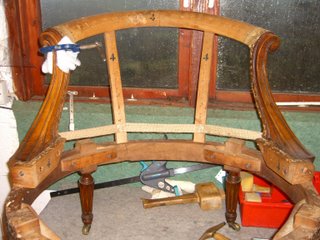Revival of an antique fireside chair





I bought this tired-looking French antique chair in a second-hand shop in Wales. It had an old-fashioned pink velvet fabric, the seat had lost its shape and the buttons were loose. It also came with a small surprise: after removing all the old stuffing, the frame turned out to be severely damaged - it was more or less a chair in two pieces. That wouldn't worry an upholsterer though - some glue, a few screws in the right places and a clamp will take care of the problem. I re-upholstered the chair according to traditional methods (which by the way haven't changed much since the 18th century) and gave it a deep-buttoned back. I chose a damask in a rich red colour to match the antique style of the chair - et voila, a new chair was born! Don't think I will sell this one...

0 Comments:
Post a Comment
<< Home